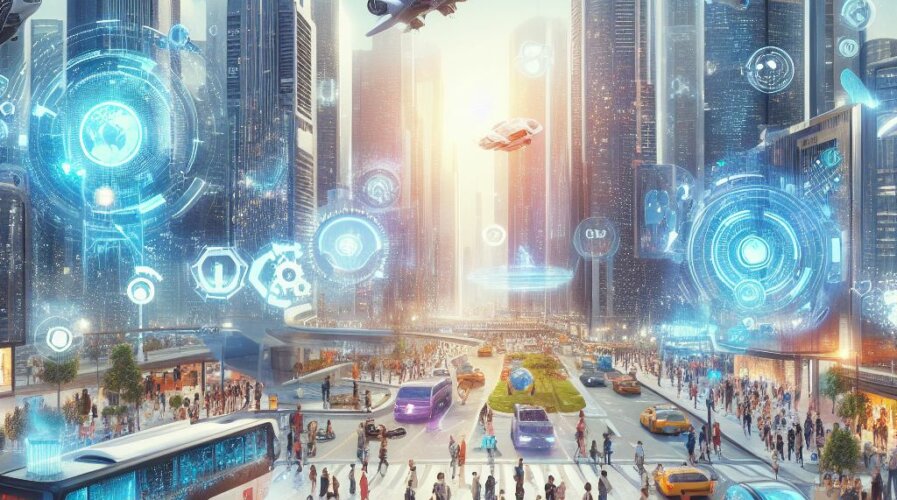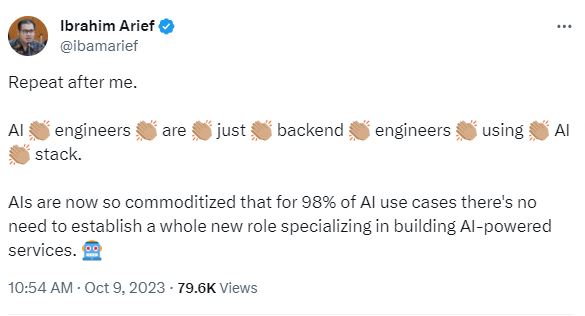
The world wants more generative AI use cases. (Image generated by AI)
Some of the weirdest generative AI use cases just got weirder
- Increasingly, generative AI use cases are being developed.
- OpenAI has made the technology easily accessible for developers to create more apps.
- Some generative AI use cases can be a concern to society.
Following the ChatGPT explosion, generative AI has found its way into almost any conceivable use case today. From simple use cases in the office to complicated ones like managing cybersecurity, generative AI use cases continue to grow with its evolving capabilities. While most of these use cases make sense and can be justified, some startups and even large corporations have developed some pretty weird – yet fascinating – generative AI use cases as well.
There is no denying that AI has done wonders for some industries. For example, AI in healthcare has helped with diagnosis, patient care, and administration. In finance, AI capabilities have enabled financial institutions to improve fraud management. In e-commerce, retailers are using AI to understand their customers better and also manage their supply chain.
Despite concerns about AI bias, privacy, and even copyright, most businesses feel that the benefits of using the technology are much higher. In fact, 78% of respondents from a recent Gartner poll of more than 1,400 executive leaders believe that the benefits of generative AI outweigh its risks.
While most of the AI adoption for enterprises has been clearly defined, some startups and enterprises have been developing several interesting generative AI use cases. For them, these use cases show the capabilities of the technology, but some feel that the use cases simply do not make sense.

The development of generative AI use cases – has it become too commoditized?
10 ingenious yet weird generative AI use cases
Here’s a look at ten of the weirdest AI use cases that have been developed. Do note that these generative AI use cases are actually available in some countries.
A perfect set of teeth: the AI toothbrush
An AI toothbrush was produced by renowned dental hygiene company Oral-B. The Oral-B Genius X Electric toothbrush uses AI to track how people brush their teeth and gives them real-time feedback for the best results every day.
The toothbrush is built with an iO magnetic technology that combines micro–vibrating bristles with Oral–B’s round brush head for a professional clean feeling. The toothbrush’s display will turn red when brushing too hard or white when brushing too lightly. At the perfect speed of brushing, it will turn green.
No more overcooked meals: AI for the kitchen
Flippy, the kitchen robot that makes burgers. Powered by Miso’s proprietary and patent-protected AI, Flippy is a smart commercial kitchen robot that fries items from french fries to chicken nuggets and works alongside humans to enhance quality and consistency, while creating substantial, measurable cost savings for restaurants.
The machine is equipped with an array of sensors, cameras and intelligent algorithms that allow it to fry food. Flippy can also adapt to various cooking techniques and recipes, making it a versatile addition to any kitchen environment.
Too good to be true: AI fake news generator
As if there already isn’t enough misinformation and disinformation on the web, Grover is an AI tool that creates fake news. According to reports, Grover is trained on a large chunk of internet content, which it uses to create news articles that are almost indistinguishable from those written by real people.
But here’s where it gets interesting. A study by Grover’s developers claims that the best way to detect fake news is to use a model that is also a generator. As such, Grover is a generator that can easily spot its own generated fake news articles, as well as those generated by other AIs. What’s amazing is that it obtained a 92% accuracy at telling human-written news from the machine-written version.
Purr of pain: the cat pain detector
Cats purr and meow to express themselves. They could be hungry, sick, or just bored. But sometimes, it is hard to tell how the cat really feels. For cat lovers in Japan, a technology firm and a Tokyo-based university have invented a new web app that uses AI to detect if a pet cat is in pain.
The Cat Pain Detector app has an alleged accuracy level of more than 90%. The AI detection system relies on 6,000 photos of cats, where it studies a cat’s whiskers, eyelids, ears, and nose, which are then fed to a scoring system to measure differences between healthy cats and those supposedly suffering in pain due to less visible illnesses.
The app’s popularity has seen it grow to have some 43,000 users across Japan, Europe, and South America since its June 2023 launch.
Size doesn’t matter: an AI penis recognition tool
And if that wasn’t weird enough, a Singapore healthcare platform has developed an app that can check male STDs by allowing users to send in digital images of their penises for analysis and receive their results anonymously. The “penis-checking” tool is powered by a customized convolutional neural network (CNN) AI model. With instant results, the HeHealth platform can also detect other types of penile conditions such as penile cancer.
For those concerned about their privacy and data security, HeHealth states that it does not collect any personally identifiable information. Although users still need to create an anonymous account to use the services, the company ensures multiple layers of data protection that meet HIPAA guidelines.
Moonwalkers: the AI-powered electric shoes
Meanwhile, those who enjoy strolling but are too lazy to do so can now rely on AI-powered walking shoes called Moonwalkers. They function like any other shoe, but what sets them apart is their AI that learns walking patterns and automates the movement. The US$ 1,000 shoe is proving popular.
“To walk faster, you just walk faster. To slow down, walk slower. To stop, well, you stop walking,” said the company in its media release. Doesn’t sound too complicated now, does it?
Best taken neat: AI whisky
For those who love whisky, Swedish-based Mackmyra Whisky is collaborating with Microsoft and Finnish tech firm Fourkind to create the world’s first AI-developed whisky. But it does make some sense, as the company will feed Mackmyra’s existing recipes, cask types, sales data and customer preferences into the AI model. According to Microsoft, the AI can produce “more than 70 million recipes that it predicts will be popular,” including new combinations that human Master Distillers might never have thought up.
Sleeping like a baby: AI Mattress
Memory foam has been around for some time and is now built-in to most shoes and even mattresses. While memory foam fits itself based on a walking or sleeping style, a company has come up with an autonomous adaptation module AI trackbot to do this on the mattress. The HEKA AI mattress can collect body pressure distribution data in real-time, independently recognize body shapes and sleep positions, and calculate the optimal pressure distribution for sleep positions based on Sleep Medicine databases.
The mattress will then make autonomous adjustments in mattress height and firmness for changing sleeping positions. Such functions ensure that the body stays properly aligned and properly supported during sleep.

Could AI use cases be everywhere? (Image generated by AI)
A scent to kill: AI perfume
The perfume industry continues to come up with innovative scents. While most of the scents are created by researchers who mix various chemicals to get the best out of them, AI is now capable of making the process faster.
Algorithmic Perfumery is the world’s first AI-guided scent creation platform that helps users explore the world of scent. The platform can be used to create personalized scents by customizing creations from its in-house library. Frederick Duerinck, an artist technologist worked with scent designer Anahita Mekanik to offer a new way to interact with scent by manipulating the creation process with AI.
Praise be to God: AI pastors and preachers
While AI is not God (as far as can be determined at this time), some are using the technology to communicate with God better. That’s right, AI pastors and preachers are becoming a hit in some countries around the world.
In South Korea, Meadow is a ChatGPT-based bible chatbot service that suggests Bible verses and customizes prayers for users based on the problems they discuss with the chatbot. Apparently, it has become popular among young Protestants in their 20s and 30s.
Earlier this year in Germany, a ChatGPT bot embodied by multiple on-screen avatars oversaw a 40-minute devotional for over 300 congregants at St. Paul’s church in the Bavarian town of Fuerth. However, reports state that the AI service left many feeling spiritually unfulfilled.
AI’s impact on society
Given the impact of generative AI, there is no denying that the technology will only continue to be popular among users. While some fear AI could replace them at work, the reality is, that AI can also do a lot more than just take over jobs.
The use cases highlighted are just some of the many that continue to be developed. However, there are also use cases that are being developed for the wrong reasons. For example, AI deepfake generators are being used to create pornographic and fake news content that could be a big problem for society.
This is also why some countries are regulating how and what AI can be used for. While many feel regulations will only slow down innovation of the technology, they are actually meant to protect privacy and society a lot more.
The bottom line is that the world will only see more generative AI use cases being developed. It will be up to society, businesses and leaders to decide how much AI they want to rely on.
READ MORE
- 3 Steps to Successfully Automate Copilot for Microsoft 365 Implementation
- Trustworthy AI – the Promise of Enterprise-Friendly Generative Machine Learning with Dell and NVIDIA
- Strategies for Democratizing GenAI
- The criticality of endpoint management in cybersecurity and operations
- Ethical AI: The renewed importance of safeguarding data and customer privacy in Generative AI applications






